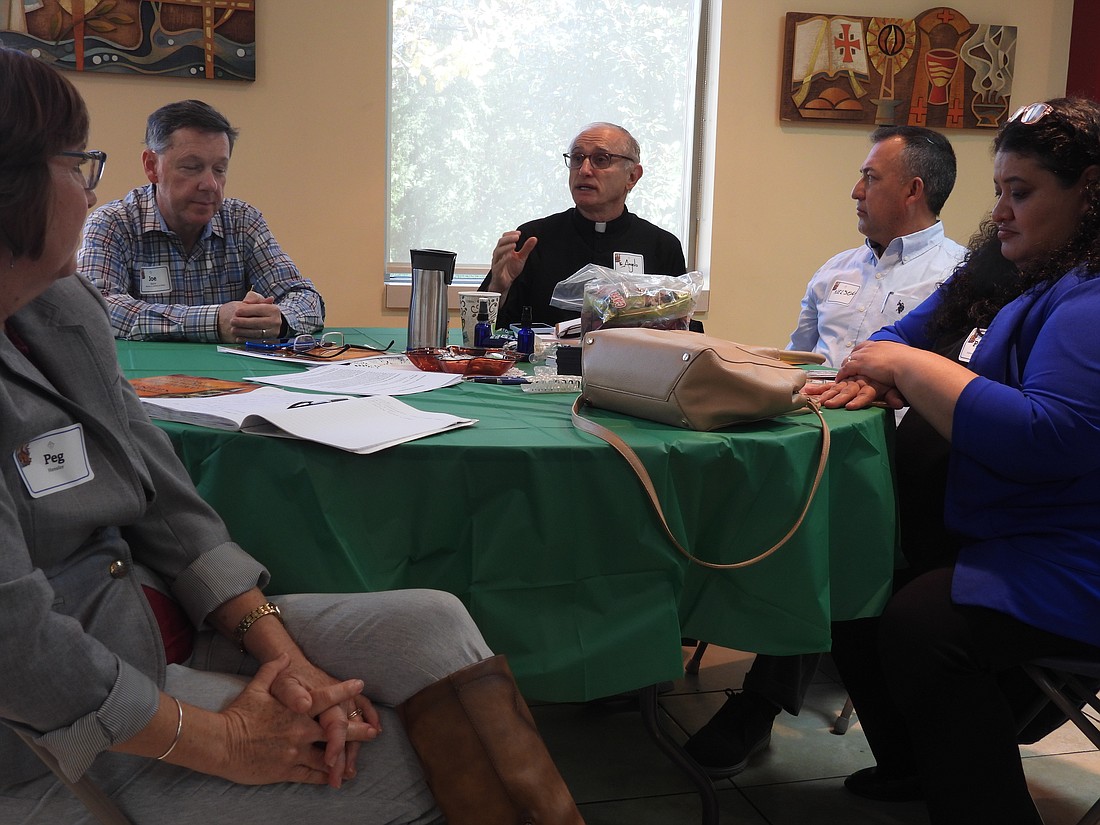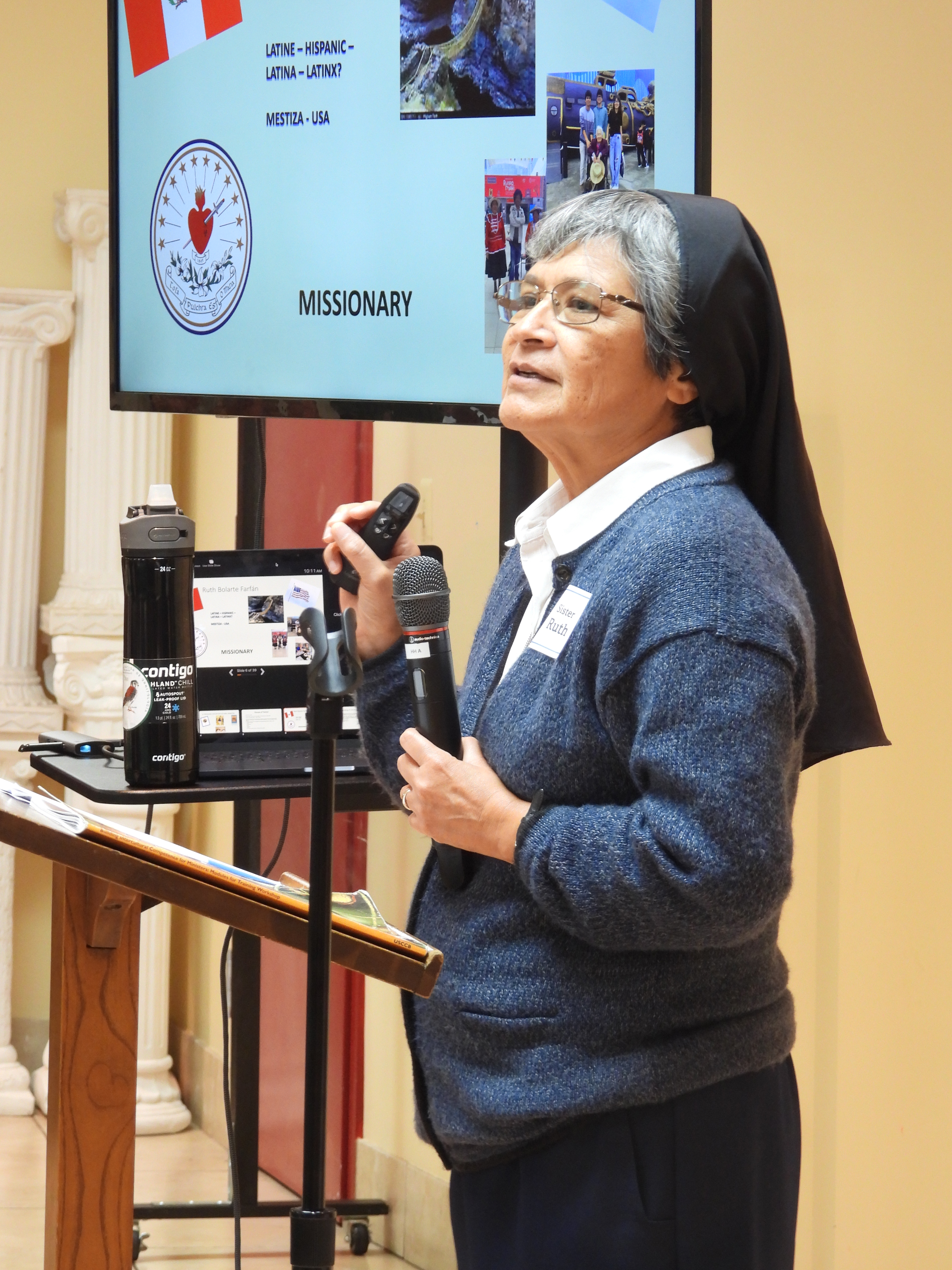UPDATED: Conference zeroes in on cultural challenges, opportunities for connection
November 29, 2023 at 10:59 a.m.
|
Updated November 29, 2023 at 10:54 a.m.

“We need space to get to know each other … Only in dialogue — and as Pope Francis says, only in the culture of encounter — do we get to understand each other’s inner culture.”
Immaculate Heart of Mary Sister Ruth Bolarte, keynote speaker, shared this insight and many others during the Diocese of Trenton’s “Walking Together as Church” conference Nov. 18 at St. Anthony of Padua Parish, Hightstown. The 50-some parish leaders of various ministries who attended explored the differences between cultural interpretations of behavior and styles of communication, which can sometimes be barriers to better understanding of people from diverse backgrounds.
PHOTO GALLERY: "Walking Together As Church" conference
Observing the Terrain
“It’s interesting to know the sea you are swimming in,” said Terry Ginther, diocesan chancellor and executive director of the Office of Pastoral Life and Mission, who shared statistics of the various cultures represented in the Diocese’s 97 parishes. Ginther stressed the understanding of an “intercultural” Church — one that recognizes and appreciates the tapestry of various expressions of the Catholic faith. “Step back and look at what culture means; it’s so much deeper than different foods, languages and dress.”
Sister Ruth pointed out that the theological term “inculturation” speaks to the relationship between culture and God. “How do we experience God and manifest our spiritual life?” she asked. “As missionaries, we need to take into consideration the culture of the people we are working with. We are called to affirm the Gospel that is already in the culture, but we are also called to purify, according to Gospel values.”
Participants had several opportunities for small-group discussions. One in particular addressed both old and new interpretations of the cultural mix of America and its Church.
“What are you working toward in your parishes?” Sister Ruth asked. Formerly described as a “melting pot,” the parish is currently compared to different metaphorical images: a salad, a mosaic or a stew. Although all have some relevance, Sister Ruth pointed out, there are limitations.
“The mosaic is not dynamic but fixed … the pieces are together, but not really mixed,” she explained. “The salad contributes various ingredients, but the limitation is that you can pick out what you don’t want.” In the stew metaphor, however, the ingredients remain distinct, “but they are changed through being together… because of our living together, I have changed.”
Cultural Differences as Strengths
Sister Ruth broke down the differences between “enculturation,” adapting to the norms of society; “acculturation,” changes that occur from continuous first-hand contact with another culture; and “inculturation,” a theological term for one’s ethnic dimension intersecting with spiritual life.
 Immaculate Heart of Mary Sister Ruth Bolarte speaks about various cultural groups in church communities. EmmaLee Italia photo
Immaculate Heart of Mary Sister Ruth Bolarte speaks about various cultural groups in church communities. EmmaLee Italia photoEthnocentrism — judging others through one’s own cultural reference, thinking “my way is normal, their way is weird” — is part of being human, Sister Ruth noted. “Our job is to recognize that by self-reflection and engaging in dialogue.”
One’s internal culture, she pointed out, can influence the way a person expresses their faith — either through a lens of collectivism, in which the group and relationships are prioritized, common in Asian and African cultures; or individualism, which starts with the well-being of the individual’s rights and opportunities, embraced by many Western cultures.
“Both are OK — they are just different; both have strengths and limitations,” she said, noting that more work may need to be done to engage with people whose inner culture encourages them to seek group approval first or to save face by pretending that “everything is fine.”
Engaging the Faithful
Deacon Tom Garvey of St. Anthony Parish, who is proud of the work his parish is already doing to bring its different cultures together for shared events, said, “I see how much our Spanish community brings enrichment to the spiritual life of the parish, with their great enthusiasm and celebrations of their culture.
“I would like to see more explanation — some background on what it’s all about — of what another culture is doing for different events,” he continued, pointing out that many English-speaking parishioners are unfamiliar with their significance.
Kathleen McGrorry, youth minister and catechetical leader in St. Teresa of Calcutta Parish, Bradley Beach, said “What stood out to me was the [discussion of] ethnocentrism, where we judge others through our own eyes.” She also was intrigued by the topic of the “survival mode” many people from non-Western cultures enter when adapting to the Church in the United States. Moving forward, her ideas include “trying to meet people where they are, not just to include but to accommodate.”
“Today I’ve been able to recognize and accept that there are different ways not only to connect with the community, but with the Catholic Church overall,” said Ana Acatitla Cosme, religious education secretary and catechetical leader in Our Lady of Guadalupe Parish, Lakewood. Training opportunities like the Walking Together as Church conference are important, she said, because “you get to see that certain things you have been doing [in ministry] aren’t so normal for other people. I’m definitely taking some ideas back [to my parish], such as being able to [recognize how] people’s traditional and cultural events connect with the Catholic Church.”
Related Stories
Monday, December 15, 2025
E-Editions
Events
“We need space to get to know each other … Only in dialogue — and as Pope Francis says, only in the culture of encounter — do we get to understand each other’s inner culture.”
Immaculate Heart of Mary Sister Ruth Bolarte, keynote speaker, shared this insight and many others during the Diocese of Trenton’s “Walking Together as Church” conference Nov. 18 at St. Anthony of Padua Parish, Hightstown. The 50-some parish leaders of various ministries who attended explored the differences between cultural interpretations of behavior and styles of communication, which can sometimes be barriers to better understanding of people from diverse backgrounds.
PHOTO GALLERY: "Walking Together As Church" conference
Observing the Terrain
“It’s interesting to know the sea you are swimming in,” said Terry Ginther, diocesan chancellor and executive director of the Office of Pastoral Life and Mission, who shared statistics of the various cultures represented in the Diocese’s 97 parishes. Ginther stressed the understanding of an “intercultural” Church — one that recognizes and appreciates the tapestry of various expressions of the Catholic faith. “Step back and look at what culture means; it’s so much deeper than different foods, languages and dress.”
Sister Ruth pointed out that the theological term “inculturation” speaks to the relationship between culture and God. “How do we experience God and manifest our spiritual life?” she asked. “As missionaries, we need to take into consideration the culture of the people we are working with. We are called to affirm the Gospel that is already in the culture, but we are also called to purify, according to Gospel values.”
Participants had several opportunities for small-group discussions. One in particular addressed both old and new interpretations of the cultural mix of America and its Church.
“What are you working toward in your parishes?” Sister Ruth asked. Formerly described as a “melting pot,” the parish is currently compared to different metaphorical images: a salad, a mosaic or a stew. Although all have some relevance, Sister Ruth pointed out, there are limitations.
“The mosaic is not dynamic but fixed … the pieces are together, but not really mixed,” she explained. “The salad contributes various ingredients, but the limitation is that you can pick out what you don’t want.” In the stew metaphor, however, the ingredients remain distinct, “but they are changed through being together… because of our living together, I have changed.”
Cultural Differences as Strengths
Sister Ruth broke down the differences between “enculturation,” adapting to the norms of society; “acculturation,” changes that occur from continuous first-hand contact with another culture; and “inculturation,” a theological term for one’s ethnic dimension intersecting with spiritual life.
 Immaculate Heart of Mary Sister Ruth Bolarte speaks about various cultural groups in church communities. EmmaLee Italia photo
Immaculate Heart of Mary Sister Ruth Bolarte speaks about various cultural groups in church communities. EmmaLee Italia photoEthnocentrism — judging others through one’s own cultural reference, thinking “my way is normal, their way is weird” — is part of being human, Sister Ruth noted. “Our job is to recognize that by self-reflection and engaging in dialogue.”
One’s internal culture, she pointed out, can influence the way a person expresses their faith — either through a lens of collectivism, in which the group and relationships are prioritized, common in Asian and African cultures; or individualism, which starts with the well-being of the individual’s rights and opportunities, embraced by many Western cultures.
“Both are OK — they are just different; both have strengths and limitations,” she said, noting that more work may need to be done to engage with people whose inner culture encourages them to seek group approval first or to save face by pretending that “everything is fine.”
Engaging the Faithful
Deacon Tom Garvey of St. Anthony Parish, who is proud of the work his parish is already doing to bring its different cultures together for shared events, said, “I see how much our Spanish community brings enrichment to the spiritual life of the parish, with their great enthusiasm and celebrations of their culture.
“I would like to see more explanation — some background on what it’s all about — of what another culture is doing for different events,” he continued, pointing out that many English-speaking parishioners are unfamiliar with their significance.
Kathleen McGrorry, youth minister and catechetical leader in St. Teresa of Calcutta Parish, Bradley Beach, said “What stood out to me was the [discussion of] ethnocentrism, where we judge others through our own eyes.” She also was intrigued by the topic of the “survival mode” many people from non-Western cultures enter when adapting to the Church in the United States. Moving forward, her ideas include “trying to meet people where they are, not just to include but to accommodate.”
“Today I’ve been able to recognize and accept that there are different ways not only to connect with the community, but with the Catholic Church overall,” said Ana Acatitla Cosme, religious education secretary and catechetical leader in Our Lady of Guadalupe Parish, Lakewood. Training opportunities like the Walking Together as Church conference are important, she said, because “you get to see that certain things you have been doing [in ministry] aren’t so normal for other people. I’m definitely taking some ideas back [to my parish], such as being able to [recognize how] people’s traditional and cultural events connect with the Catholic Church.”










